Varanasi
City of Sumptuous Silks and 10,000 temples
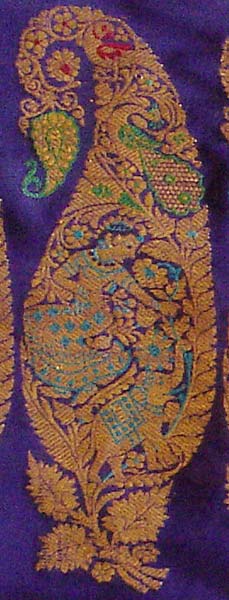 Varanasi silks were some of the first to come into the collection, and are sold all in shops all over India. Now finally through the invitation of a friend from home I leapt at the chance to extend my stay another two weeks and come here. Varanasi is India's most holy city. Performing last rites in Varanasi you will be freed from the cycle of birth and death, and immediately be released into moksha. Varanasi silks were some of the first to come into the collection, and are sold all in shops all over India. Now finally through the invitation of a friend from home I leapt at the chance to extend my stay another two weeks and come here. Varanasi is India's most holy city. Performing last rites in Varanasi you will be freed from the cycle of birth and death, and immediately be released into moksha.
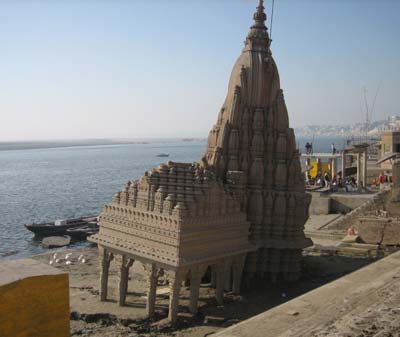 Many Hindus come here to die, or bring their loved ones for the final send off to the infinite. The Old City is steeped in an amazing holiness and peace - so many millions coming for prayers, offering their souls here into the Ganga have infused the city with a tangible holiness. On the teeming narrow lanes snaking their way through the buildings built on the steep banks of the river, you encounter at least a temple every few paces - even the tiny shops seem like temples. The streets are too narrow for cars so only two wheeled traffic is allowed through, and many of the walkways have stairs so there is very little motorized traffic. Many Hindus come here to die, or bring their loved ones for the final send off to the infinite. The Old City is steeped in an amazing holiness and peace - so many millions coming for prayers, offering their souls here into the Ganga have infused the city with a tangible holiness. On the teeming narrow lanes snaking their way through the buildings built on the steep banks of the river, you encounter at least a temple every few paces - even the tiny shops seem like temples. The streets are too narrow for cars so only two wheeled traffic is allowed through, and many of the walkways have stairs so there is very little motorized traffic.
Sitting anywhere along any of the thoroughfares to the river you will see a funeral procession, chanting Ram Nam Sat Kaya, bearing their loved one, or patron on their shoulders. The biers are a simple bamboo ladder mostly, with the wealthier souls getting more decoration and ceremony for the final rites. It is strange to feel quite used to it, the straightforward nonchalance that the Varanasis show around death is also quite remarkable. They have learned to live with bodies going through their neighborhoods.
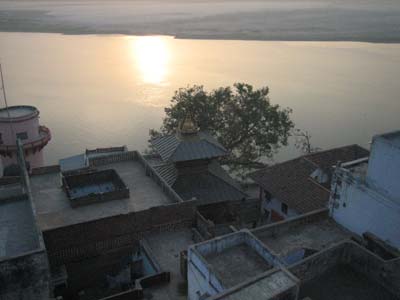 Sunrise and sunset is spectacular from the roof of my guesthouse. People are living their lives up on their rooftops. From here you can look down onto the roof of neighboring houses and see dishes being washed, cooking, children playing, flying kites, dogs, goats and chickens strolling through it all. Sunrise and sunset is spectacular from the roof of my guesthouse. People are living their lives up on their rooftops. From here you can look down onto the roof of neighboring houses and see dishes being washed, cooking, children playing, flying kites, dogs, goats and chickens strolling through it all.
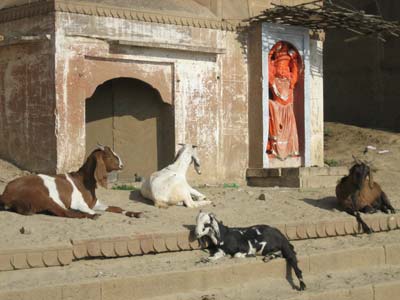 Goats enjoying the warm sunshine and blending right in front of a small Hanuman shrine. Goats enjoying the warm sunshine and blending right in front of a small Hanuman shrine.
Varanasi brocades. Hundreds of years of history in silk
These weavers are working on both punch card jacquard looms and the old style of brocade weaving using tedious string tie ups. The man on the high bench behind the loom does his part of the patterning by tying up the appropriate warp threads in the correct sequence. He has a completely complicated and detailed job, managing the 3500 or so warp threads! The man on the bench manages the many spools of different color areas in the brocade, as well as operating the peddles and throwing the shuttle to weave the ground cloth.
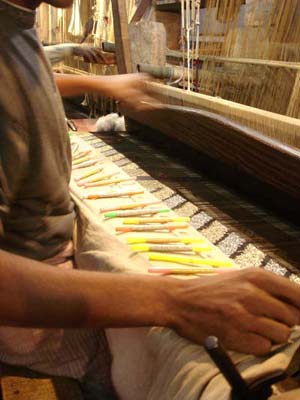
|
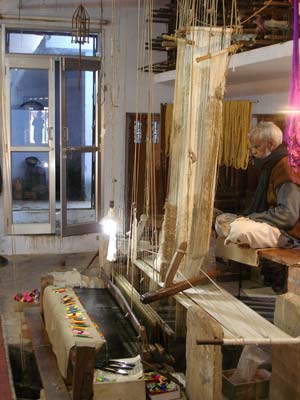
|
This old style of patterning was replaced by jacquard machines with punch card operation. Heavy cardboard punch cards are fed through a mechanism that lifts the appropriate threads, allowing a weaver to work alone to create very complex patterning. These skills have been traditionally passed down by masters to their sons and charges. Weaving, because of it's low status and pay is no longer a sought after profession for the coming generations, and many Benaras weaving families are ending their traditions with the death of their elders. The weavers are living hand to mouth for the most part, and can't afford to invest in materials themselves and sit on the products until their eventual sale. Most work as independent contractors for a guaranteed amount.
It is impossible to keep a craft alive and thriving without masters dedicated to innovation and excellence, and a cultural and economic environment of support. In recent years Varanasi sarees have retained their mystique as a perfect wedding sari, but are not so much in fashion, so the industry is definitely in a down phase. Thanks to Stephen Spyrit for these photos of the looms.
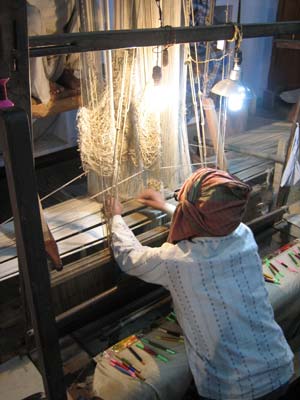 Looking at the jacquard machine suspended over the loom, you can see a big bundle of cards. There are probably 100 to 200 just for this section alone, and some of the heavy pallus require thousands of cards. Looking at the jacquard machine suspended over the loom, you can see a big bundle of cards. There are probably 100 to 200 just for this section alone, and some of the heavy pallus require thousands of cards.
Watching the punch card in action was amazing, but this particular showroom - an overpriced place too close to five star hotels - they had the old style of patterning with string heddles that need to be carefully lifted in sequence by a man sitting above the loom. The string heddles look like a mass of indecipherable spaghetti, they are all muslin white. Once the shaft is established the weaver inserts these large wooden shims to hold the shaft open while the heddle guy goes in search of the next weft sequence. Seeing this really can send a sari wallah off into the netherworld, ending in tears of wonder and amazement.
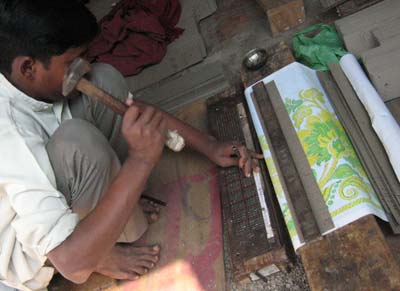
Below is a punch card maker at work. He has a diagram of the pattern in front of him and translates that to the shaft patterning on the punch card. Depending on how many holes, and where pins are allowed to pierce the card and lift the shafts. He's weaving in 12 colors so the card has twelve rows of puncholes.

Many linghams along this narrow lane leading down to the ghat. These are lamps and puja supplies hung on the tree. A couple had little ghee flames burning in them.
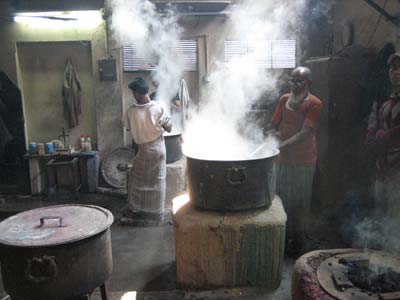
Dying silk in a back alley production house in one of Varanasi's weaving community areas, this one primarily a Muslim neighborhood. I've been searching for figurework sarees for certain collectors. They are impossible to find here , the reason I hear is that the Muslim weavers won't make them - they are forbidden to work with images of any kind. There are enough Hindu weavers though and I found a few nonetheless in the old city.
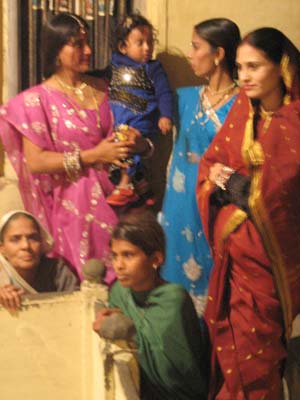
It's wedding season now in January and I was lucky to get invited to the wedding of a Ganges boatman, a very friendly and sincere man named Madan who went in for the very traditional version of seeing his bride for the first time at the ceremony. It was a huge family gathering with 2 full days of ceremony and all night rituals and parties ending in the men madly dancing and staying the whole night out on the ghats.
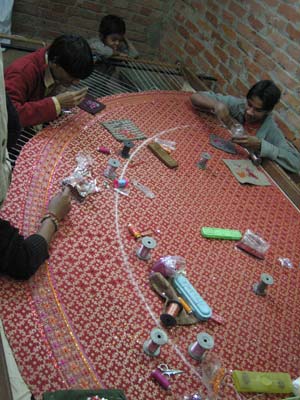
Embroiderers working on a Lehenga Choli wedding dress. Takes the five guys four days to finish it. Embroidery work is big in fashion all over India right now, to a detriment to the handloom weavers of India who struggle to keep their looms and heritage going in a fickle fashion industry.
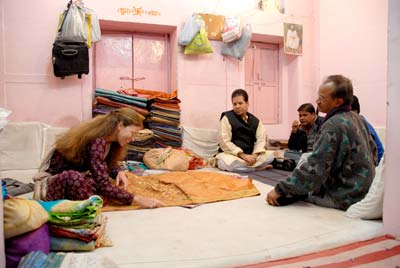
The Varanasi shop keepers are pretty ruthless, too used to five star tourists giving them triple what their things are worth! It will take a few times of coming here to really sleuth out the best dealers! Thanks to Daniel Vasku for this photo.
Back to the textile tour start page
All images and text © Sarisafari
|




 Varanasi silks were some of the first to come into the collection, and are sold all in shops all over India. Now finally through the invitation of a friend from home I leapt at the chance to extend my stay another two weeks and come here. Varanasi is India's most holy city. Performing last rites in Varanasi you will be freed from the cycle of birth and death, and immediately be released into moksha.
Varanasi silks were some of the first to come into the collection, and are sold all in shops all over India. Now finally through the invitation of a friend from home I leapt at the chance to extend my stay another two weeks and come here. Varanasi is India's most holy city. Performing last rites in Varanasi you will be freed from the cycle of birth and death, and immediately be released into moksha.  Many Hindus come here to die, or bring their loved ones for the final send off to the infinite. The Old City is steeped in an amazing holiness and peace - so many millions coming for prayers, offering their souls here into the Ganga have infused the city with a tangible holiness. On the teeming narrow lanes snaking their way through the buildings built on the steep banks of the river, you encounter at least a temple every few paces - even the tiny shops seem like temples. The streets are too narrow for cars so only two wheeled traffic is allowed through, and many of the walkways have stairs so there is very little motorized traffic.
Many Hindus come here to die, or bring their loved ones for the final send off to the infinite. The Old City is steeped in an amazing holiness and peace - so many millions coming for prayers, offering their souls here into the Ganga have infused the city with a tangible holiness. On the teeming narrow lanes snaking their way through the buildings built on the steep banks of the river, you encounter at least a temple every few paces - even the tiny shops seem like temples. The streets are too narrow for cars so only two wheeled traffic is allowed through, and many of the walkways have stairs so there is very little motorized traffic. Sunrise and sunset is spectacular from the roof of my guesthouse. People are living their lives up on their rooftops. From here you can look down onto the roof of neighboring houses and see dishes being washed, cooking, children playing, flying kites, dogs, goats and chickens strolling through it all.
Sunrise and sunset is spectacular from the roof of my guesthouse. People are living their lives up on their rooftops. From here you can look down onto the roof of neighboring houses and see dishes being washed, cooking, children playing, flying kites, dogs, goats and chickens strolling through it all.  Goats enjoying the warm sunshine and blending right in front of a small Hanuman shrine.
Goats enjoying the warm sunshine and blending right in front of a small Hanuman shrine.

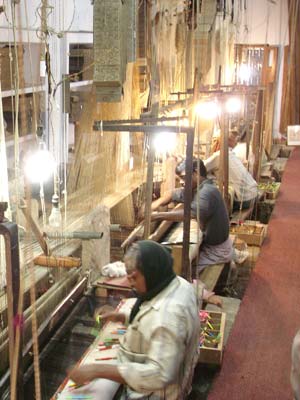
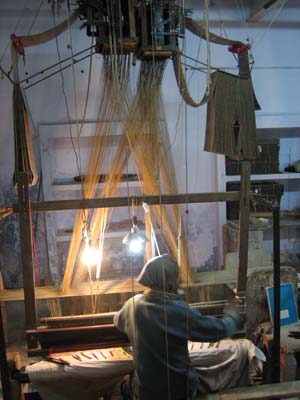
 Looking at the jacquard machine suspended over the loom, you can see a big bundle of cards. There are probably 100 to 200 just for this section alone, and some of the heavy pallus require thousands of cards.
Looking at the jacquard machine suspended over the loom, you can see a big bundle of cards. There are probably 100 to 200 just for this section alone, and some of the heavy pallus require thousands of cards. 




